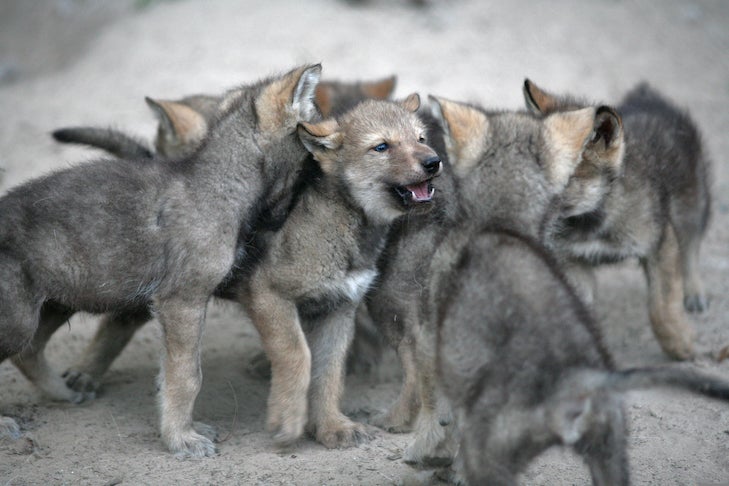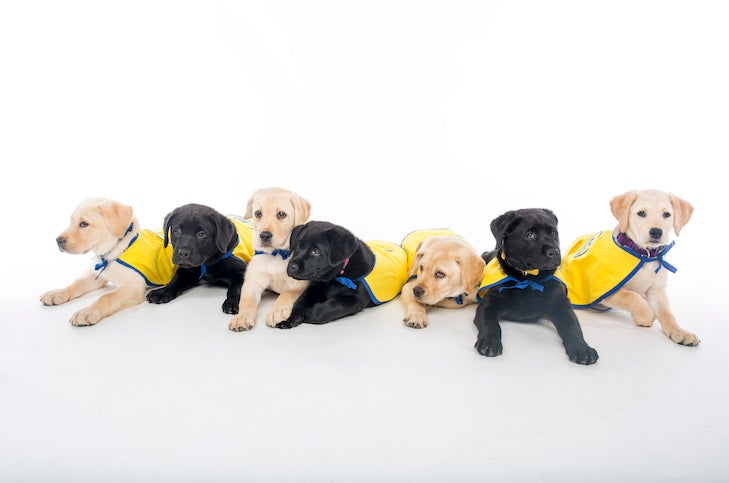
The relationship you have with your dog is unlike that of any other pet. Although your cat or your horse may read your emotions, no other animal reads human gestures like a dog. In fact, even mother-reared chimpanzees, one of our closest living relatives, can’t compete with dogs when it comes to reading the gestures we use to cooperate, such as pointing. But dogs are closely related to gray wolves, so how do wolves stack up in terms of understanding people? If wolf puppies receive the same around-the-clock human attention as dog puppies, can they learn to read us too? Recent research published in Current Biology from Dr. Brian Hare’s lab at Duke University explored that very question.
Dogs and Wolves Share a Common Ancestor
Dogs and gray wolves share a common ancestor and are so closely related they can interbreed and produce wolf-dog hybrids. But how did dogs come to be? Nobody’s sure, but somewhere between 12,000 and 40,000 years ago, dogs began to evolve from that wild wolf ancestor to the human companion of today. And that evolution shaped not only dogs’ bodies and behavior but their brains as well.
What led to dogs’ uncanny ability to understand our communicative gestures? Scientists have developed two hypotheses: the Domestication Hypothesis and the Canid Ancestry Hypothesis. According to Hannah Salomons, a doctoral student in Dr. Hare’s lab and first author on the research paper, the Domestication Hypothesis states that as early dogs diverged from their wolf ancestor and lost their fear and aggression towards humans, they developed the ability to read us. This hypothesis predicts that in the current study, “we would see these skills in dog puppies but not wolf puppies.”
The Canid Ancestry Hypothesis states that both dogs and gray wolves inherited these communication skills from their common ancestor. So, wolves should be just as talented as dogs if they’re raised in the same human-centric environment. Therefore, Salomons explains, “we would see these skills in wolf puppies too if they had the opportunity to learn from experience with humans.”

Cuddling Wolves
The researchers tested 44 dog puppies who were between five and 18 weeks old. The pups were all Labrador Retrievers, Golden Retrievers, or Lab-Golden mixes who were from assistance dog lines. The puppies had many hours of exposure to human caregivers every day, but they lived and slept with their littermates. Most of the dog testing was done at Canine Companions for Independence.
The researchers also tested 37 wolf puppies within the same age range. The wolf pups all came from the Wildlife Science Center, and before participating in the study, genetic testing ensured the wolves had no dog DNA but rather were of wild North American wolf ancestry. To give the wolves the same advantage as the dogs, the wolves were raised by human caretakers. In fact, the wolf pups had more contact with humans than the dog pups did. The wolves were hand-fed, had 24-hour attention, and even slept on or beside their caretaker in the caretaker’s bed each night.
Salomons notes that hand-rearing the wolf pups was not done specifically for the study but is part of Wildlife Science Center’s typical husbandry practice – an enormous feat in and of itself. She says, “Being able to test such a large sample of wolf puppies was a huge undertaking that took our team over 6 years to complete – only a few litters are born at Wildlife Science Center per season, and despite being raised by humans round-the-clock from just a few days old, some of the wolf puppies are so shy around people that they never warm up to the experimenter enough to participate in the study.”
Testing the Puppies
Both the wolf pups and the dog pups participated in several non-social cognitive tests of skills such as memory and motor impulse control. For example, they had to retrieve food hidden behind a transparent obstacle and needed to detour around the obstacle to succeed. In these non-social tests, the dogs and wolves were equally skilled. In other words, it’s not a case of one species being smarter than the other.
However, as soon as humans were involved in the tests, the dogs outshone the wolves. One social test looked at the pups’ ability to read pointing gestures. The researchers hid a treat in one of two bowls then pointed and stared at the correct bowl. Even without any previous training, dog puppies as young as eight weeks old chose the correct bowl. On average, the dog puppies were twice as likely to get it right as the wolf puppies.
Another social test was unsolvable. The pups were given a sealed container that they had previously been able to open. The container contained food, and there was a person in the testing enclosure. The wolf puppies tried to solve the problem on their own, but the dog puppies turned to the human for help. Yet another test measured how often the pups would approach a stranger, and the dog pups were 30 times more likely to approach than the wolf pups.
According to Salomons, “The wolf puppies were much more shy, especially with strangers! They showed less interest in humans in general, even people with whom they were familiar and comfortable. The dog puppies, on the other hand, were much more likely to approach and touch a person, regardless of whether they were a stranger or a known friend.”
Wolf puppies at Wildlife Science Center in Minnesota, where testing took place.
Wolves Can’t Understand You Like Your Dog Does
So, it seems the Domestication Hypothesis won out in this study. Despite their human-focused upbringing, the wolves didn’t show the same ability to read humans as the dogs. And it’s not just because the dog puppies came from assistance dog lines. Earlier research has found that adult assistance dogs are no better at using human pointing gestures than adult pet dogs.
Salomons, who is grateful to Wildlife Science Center and Canine Companions for Independence for making the research possible, wasn’t surprised by her results because they fit with previous studies of dog puppies. “We were pleased to be able to clarify the findings as far as comparisons to wolves go, though. Previous comparative studies with wolves had small sample sizes and conflicting results, so here we were thrilled to be able to draw strong conclusions with the largest sample of wolf puppies ever tested on these tasks!”

